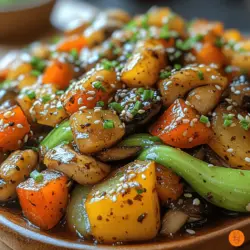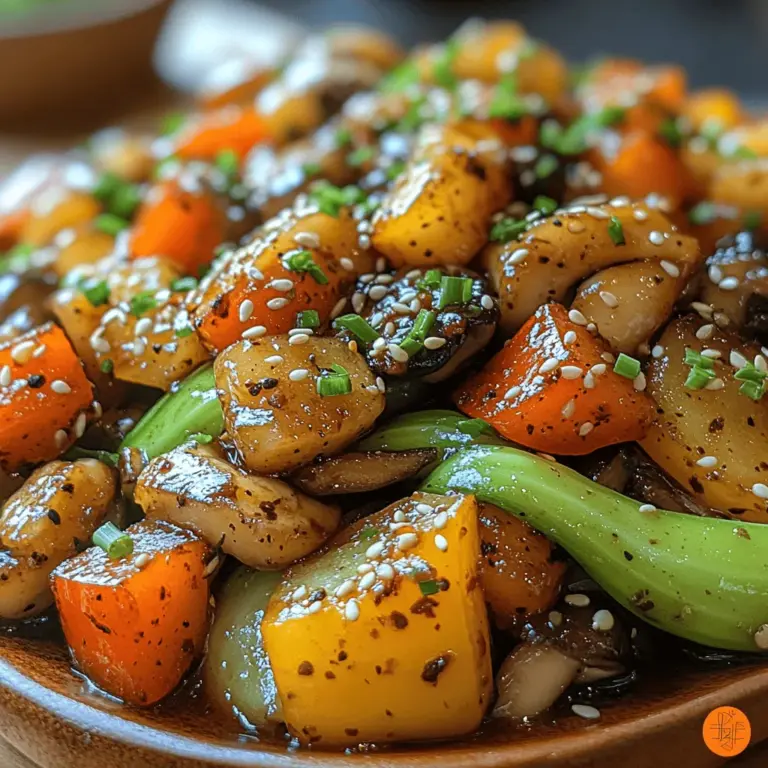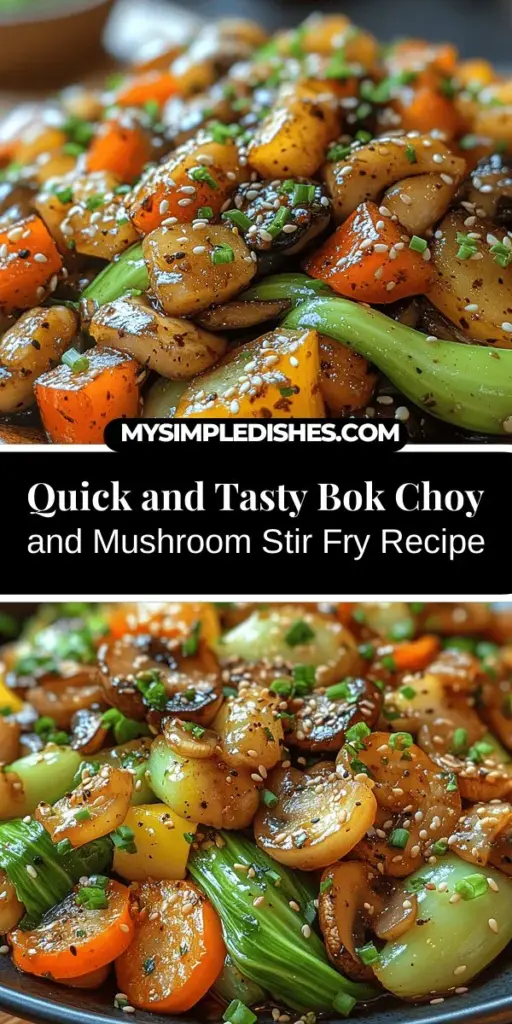In today’s fast-paced world, finding quick, nutritious meals can often feel like a challenge. Whether you’re juggling work commitments, family responsibilities, or simply trying to maintain a balanced lifestyle, preparing healthy dishes can sometimes take a back seat. Enter the savory bok choy and mushroom stir fry—a delightful dish that not only tantalizes your taste buds but also packs a punch of nutrients. This recipe combines fresh bok choy, hearty mushrooms, and vibrant bell peppers, creating a colorful meal that is as visually appealing as it is delicious.
This stir fry is not just a feast for the eyes; it’s a powerhouse of health benefits. Bok choy, a member of the cabbage family, is known for its crisp texture and mild flavor, making it an excellent base for a variety of dishes. When sautéed with mushrooms and bell peppers, it transforms into a wholesome meal that can be prepared in under 30 minutes. Whether you’re a seasoned home cook or a beginner in the kitchen, this stir fry offers a straightforward approach to cooking that can fit seamlessly into your weekly meal planning.
Understanding Bok Choy: Nutritional and Culinary Benefits
Exploring the Nutritional Profile of Bok Choy
Bok choy is more than just a pretty green vegetable; it boasts an impressive nutritional profile. Rich in vitamins A, C, and K, this leafy green is low in calories yet high in fiber, making it an ideal choice for anyone looking to maintain a healthy diet. The presence of antioxidants in bok choy also supports overall health, combating oxidative stress in the body.
– Rich in Vitamins and Minerals: Bok choy is a fantastic source of essential vitamins. Vitamin A promotes healthy vision and immune function, while Vitamin C aids in collagen production and supports the immune system. Vitamin K is crucial for bone health and blood clotting.
– Low in Calories, High in Fiber: With just 20 calories per cup, bok choy is an excellent addition to any meal, allowing you to fill up without worrying about calorie overload. Its high fiber content aids digestion and keeps you feeling satiated longer.
– Benefits for Heart Health and Digestion: Regularly incorporating bok choy into your diet can contribute to heart health, as it contains potassium which helps regulate blood pressure. Additionally, its fiber aids in digestion, making it a great choice for a healthy gut.
Culinary Versatility of Bok Choy
One of the most appealing aspects of bok choy is its culinary versatility. It can be used in a variety of cuisines, from Chinese to Thai, and even in Western dishes. This adaptability makes bok choy an excellent vegetable to keep stocked in your kitchen.
– How Bok Choy Can Be Utilized in Various Cuisines: In Asian cooking, bok choy is often stir-fried, steamed, or added to soups. Its mild taste allows it to absorb the flavors of the sauces and spices it’s cooked with, making it a favorite in many traditional dishes.
– Pairing Suggestions with Other Ingredients: Bok choy pairs beautifully with garlic, ginger, and soy sauce, enhancing its flavor profile. It also complements proteins like chicken, tofu, and shrimp, making it a flexible ingredient in many recipes.
Mushrooms: A Flavorful Addition to Your Stir Fry
When it comes to adding depth and flavor to a dish, mushrooms are hard to beat. They not only provide a satisfying texture but also contribute a rich umami flavor, making them a perfect companion in a stir fry.
Types of Mushrooms to Use
The world of mushrooms is vast, with various types offering unique flavors and textures. For this stir fry, consider using shiitake or cremini mushrooms.
– Shiitake vs. Cremini: Flavor Profiles and Uses: Shiitake mushrooms have a robust, earthy flavor and meaty texture, making them a popular choice in Asian cuisine. Cremini mushrooms, on the other hand, are milder in taste and slightly firmer, making them versatile for any stir fry.
– Health Benefits of Mushrooms: Mushrooms are low in calories and rich in important nutrients. They contain B vitamins, selenium, and antioxidants, contributing to immune function and overall health. Additionally, they are a source of plant-based protein, making them an excellent addition to vegetarian and vegan diets.
The Role of Mushrooms in Asian Cuisine
In Asian cuisine, mushrooms hold a significant place. They are often used in traditional dishes not only for their flavor but also for their health benefits.
– Traditional Uses and Cultural Significance: In many cultures, mushrooms are considered a delicacy and are often associated with medicinal properties. They are used in various dishes to enhance flavor and are celebrated in culinary traditions worldwide.
– How Mushrooms Enhance the Umami Flavor in Dishes: The rich umami flavor of mushrooms can elevate a dish, providing a savory depth that complements other ingredients. This makes them a perfect addition to stir fries, where bold flavors are key.
Gathering Your Ingredients: A Closer Look at the Essentials
To create a delicious savory bok choy and mushroom stir fry, gathering fresh, high-quality ingredients is essential. This not only enhances the flavor of your dish but also ensures you’re getting the most nutritional value from your meal.
Fresh Ingredients for Optimal Flavor
When it comes to stir fries, the quality of your ingredients can make or break the dish. Here are some tips for selecting the best bok choy and mushrooms:
– Importance of Using Fresh Produce: Fresh vegetables not only taste better but also retain more nutrients. Look for bok choy with vibrant green leaves and crisp stems, avoiding any that are wilted or yellowed.
– Tips for Selecting the Best Bok Choy and Mushrooms: For mushrooms, choose those that are firm and dry. Avoid any that appear slimy or have dark spots. When selecting bok choy, feel the stems to ensure they are firm and not soft.
Essential Pantry Staples
A few key pantry staples will enhance the flavor of your stir fry and elevate your cooking experience:
– Overview of Soy Sauce, Oyster Sauce, and Sesame Oil: Soy sauce is a common seasoning in Asian cuisine, providing saltiness and a depth of flavor. Oyster sauce adds a sweet and savory richness, while sesame oil contributes a nutty aroma that complements the other ingredients beautifully.
– Alternative Ingredients for Dietary Restrictions: If you have dietary restrictions, there are alternatives available. For a gluten-free option, look for tamari instead of soy sauce. You can also find mushroom-based sauces that mimic oyster sauce without using shellfish.
Step-by-Step Guide to Making Savory Bok Choy and Mushroom Stir Fry
Now that we’ve covered the nutritional benefits and essential ingredients, let’s dive into the step-by-step guide for making this savory bok choy and mushroom stir fry. Follow these instructions carefully to create a vibrant and flavorful dish that your family will love.
Ingredients List:
– 2 cups bok choy, chopped
– 1 cup mushrooms (shiitake or cremini), sliced
– 1 bell pepper, sliced (red or yellow)
– 2 cloves garlic, minced
– 1 tablespoon ginger, minced
– 2 tablespoons soy sauce
– 1 tablespoon oyster sauce (or mushroom sauce for a vegetarian option)
– 1 tablespoon sesame oil
– Salt and pepper to taste
– Optional: sesame seeds for garnish
Cooking Instructions:
1. Prepare the Ingredients: Start by washing and chopping the bok choy into bite-sized pieces. Slice the mushrooms and bell pepper, and mince the garlic and ginger. Having all your ingredients prepped will make the cooking process smoother.
2. Heat the Pan: In a large skillet or wok, heat the sesame oil over medium-high heat. Once the oil is hot, add the minced garlic and ginger, stirring quickly to prevent burning. Sauté for about 30 seconds until fragrant.
3. Add the Vegetables: Add the sliced mushrooms to the pan and cook for about 2-3 minutes, allowing them to soften and release their moisture. Next, add the bell pepper and bok choy, stirring well to combine.
4. Season the Stir Fry: Pour in the soy sauce and oyster sauce, stirring to coat all the vegetables evenly. Cook for an additional 3-5 minutes, or until the bok choy is tender but still vibrant green.
5. Adjust Seasoning: Taste your stir fry and add salt and pepper as needed. Be mindful of the saltiness of the soy sauce when seasoning.
6. Serve: Once everything is cooked to your liking, remove the stir fry from the heat. If desired, sprinkle sesame seeds on top for added texture and flavor. Serve immediately over steamed rice or noodles for a complete meal.
This savory bok choy and mushroom stir fry is not only simple to make but also a fantastic way to incorporate more vegetables into your diet. With its delightful combination of flavors and textures, it’s sure to become a favorite in your household.
Stay tuned for the next part of this recipe, where we will dive deeper into tips for achieving the best results and answer some common questions about cooking with bok choy and mushrooms.
{{image_1}}
Preparation Techniques
How to Properly Wash and Chop Bok Choy
Bok choy, also known as Chinese cabbage, is a versatile vegetable that adds a delightful crunch and vibrant green color to your stir fry. To prepare bok choy, start by separating the individual leaves and rinsing them thoroughly under cold water to remove any dirt or grit that may be trapped in the folds.
1. Separate the Leaves: Gently pull apart the leaves from the base of the bok choy. If you’re using baby bok choy, you can keep them whole for a more rustic presentation.
2. Rinse: Place the separated leaves in a bowl of cold water and agitate them gently to dislodge any dirt. For larger bok choy, you may need to rinse the leaves individually.
3. Chop: Once cleaned, place the leaves on a cutting board. For larger bok choy, slice the leaves into bite-sized pieces (about 2 inches long). For the stalks, cut them into half-moon shapes about 1-inch thick. This ensures even cooking, as the stalks take longer to soften than the leaves.
Slicing Mushrooms and Bell Peppers for Uniform Cooking
Mushrooms and bell peppers are essential components of this stir fry, contributing both texture and flavor. Follow these steps for optimal slicing:
1. Mushrooms: Clean your mushrooms with a damp paper towel to remove any debris. Avoid rinsing them under water, as they can absorb moisture and become soggy. Slice the mushrooms evenly, about ¼-inch thick. This size allows them to cook quickly and evenly while retaining their shape.
2. Bell Peppers: Start by washing your bell peppers thoroughly. Cut the top and bottom off, then remove the seeds and white membranes. Slice the peppers into thin strips, about ¼-inch wide. This uniformity is crucial for even cooking, ensuring that they maintain their crispness while absorbing the stir fry sauce.
Cooking Methods: Stir-Frying Basics
Understanding Heat Levels and Timing for Perfect Stir Fry
Stir frying requires high heat and quick cooking times to achieve the perfect balance of tenderness and crispness in your vegetables. Use a wok or a large skillet for the best results. Here are some guidelines to follow:
– Preheat Your Pan: Heat your wok or skillet over medium-high heat until it starts to smoke lightly. This ensures that the ingredients sizzle upon contact, which is essential for developing flavor and texture.
– Oil Temperature: Add a high smoke point oil, such as vegetable or peanut oil, ensuring it coats the surface of the pan. If the oil shimmers, it’s ready for cooking.
Importance of Ingredient Order in Stir Frying
The order in which you add ingredients to the pan is crucial for achieving perfect texture and flavor. Start with ingredients that require longer cooking times, such as mushrooms and bell peppers, and finish with quick-cooking vegetables like bok choy.
1. Stir-Fry Harder Vegetables First: Begin with the mushrooms and bell peppers, allowing them to cook for about 2-3 minutes until slightly softened.
2. Add Bok Choy Last: After the harder vegetables have started to soften, add the bok choy. Cook for another 2-3 minutes, tossing frequently until the leaves are vibrant and the stalks are tender yet crunchy.
Detailed Cooking Instructions
1. Prepare the Ingredients: Gather and prepare all your ingredients as outlined above. Having everything ready will streamline the cooking process, making it quick and efficient.
2. Heat Your Pan: Preheat your wok or large skillet over medium-high heat.
3. Add Oil: Pour in about 2 tablespoons of oil, swirling it to coat the bottom of the pan.
4. Cook the Aromatics: Add minced garlic and ginger to the oil. Stir-fry for about 30 seconds until fragrant but not browned, as burnt garlic can impart a bitter flavor.
5. Add Vegetables: Begin with the sliced mushrooms and bell peppers. Stir-fry for about 3 minutes until they start to soften.
6. Incorporate Bok Choy: Add the bok choy, stirring continuously for another 2-3 minutes until the leaves are wilted and the stalks are tender-crisp.
7. Create the Sauce: In a small bowl, mix together the soy sauce, oyster sauce, and a teaspoon of cornstarch dissolved in water. Pour this sauce over the stir-fried vegetables, ensuring an even coating.
8. Finish Cooking: Stir the mixture for an additional minute until the sauce thickens slightly. Taste and adjust seasoning with salt and pepper as desired.
9. Serve Immediately: Transfer the stir fry to a serving platter. Enjoy it hot for the best flavor and texture.
Tips for Achieving the Best Texture and Flavor
– Do Not Overcrowd the Pan: If cooking for a large group, consider doing it in batches. Overcrowding the pan can lead to steaming rather than stir-frying, resulting in soggy vegetables.
– Constant Motion: Keep the ingredients moving in the pan to prevent burning and to ensure even cooking.
– Taste as You Go: Adjust seasoning during cooking to enhance the flavors. A splash of soy sauce or a dash of salt can elevate the dish.
Enhancing Flavor: The Science Behind Each Ingredient
The Role of Garlic and Ginger
Garlic and ginger are not just flavor enhancers; they also provide numerous health benefits. Garlic contains allicin, known for its anti-inflammatory and antibacterial properties, while ginger is celebrated for aiding digestion and reducing nausea.
– Maximizing Flavor Extraction: To extract maximum flavor from garlic and ginger, mince them finely before adding them to the pan. Cooking them in hot oil releases their essential oils, enhancing the overall flavor of the stir fry.
The Importance of Sauce in Stir Fry
Sauces are the heart of any stir fry, providing moisture and flavor that brings the dish together.
– Soy Sauce and Oyster Sauce: Soy sauce adds saltiness and umami, while oyster sauce contributes sweetness and depth. Combining these two creates a well-rounded flavor profile.
– Cornstarch for Sauce Consistency: Mixing cornstarch with water before adding it to the stir fry not only thickens the sauce but also helps it adhere to the vegetables, ensuring every bite is flavorful.
Presentation and Serving Suggestions
Garnishing Your Stir Fry
Presentation is key in making your dish visually appealing. Consider these garnishing ideas:
– Sesame Seeds: Toasted sesame seeds sprinkled on top add a nutty flavor and crunch.
– Green Onions: Chopped green onions not only add color but also a fresh burst of flavor. Scatter them generously over the stir fry before serving.
Tips for Plating to Enhance Visual Appeal
– Use a White Plate: A white or neutral-colored plate allows the vibrant colors of the stir fry to stand out.
– Layering: Instead of simply dumping the stir fry on the plate, consider layering the vegetables to create height and interest.
Pairing Ideas for a Complete Meal
To round out your dining experience, consider these suggested side dishes and beverage pairings:
– Side Dishes: Serve your bok choy and mushroom stir fry with jasmine rice or quinoa to soak up the delicious sauce. For added texture, consider a side of crispy spring rolls or a light cucumber salad.
– Beverage Pairings: A chilled glass of jasmine tea or a light white wine, such as Pinot Grigio, complements the flavors of the stir fry beautifully, enhancing your overall dining experience.
Conclusion: A Delicious and Nutritious Meal for Any Occasion
The savory bok choy and mushroom stir fry stands out as a wholesome meal that can be enjoyed on any occasion—whether it’s a weeknight dinner or a special gathering. Its balance of flavors and textures not only satisfies your hunger but also supports a healthy lifestyle. By following this recipe, you can create a dish that is not only nourishing but also showcases the beautiful simplicity of stir-fried vegetables. Embrace this recipe as a staple in your cooking repertoire, and enjoy the myriad of health benefits and culinary joy it brings to your table.


